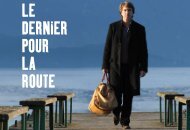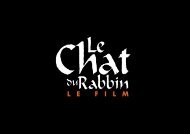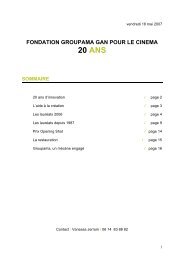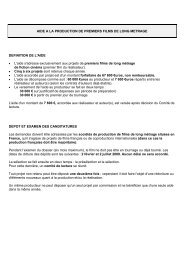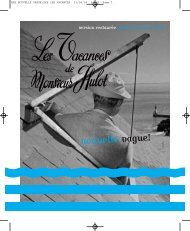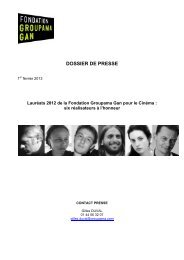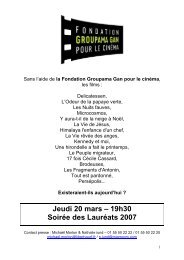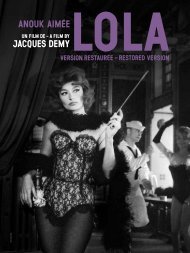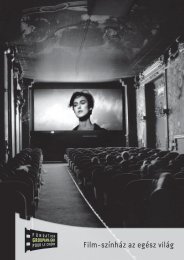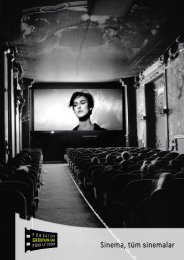duVoyage - Fondation Groupama Gan pour le Cinéma
duVoyage - Fondation Groupama Gan pour le Cinéma
duVoyage - Fondation Groupama Gan pour le Cinéma
You also want an ePaper? Increase the reach of your titles
YUMPU automatically turns print PDFs into web optimized ePapers that Google loves.
Georges Meliès<br />
1861<br />
Georges Méliès is born in<br />
Paris, 3 rd arrondissement, on<br />
December 8 th . His father is a<br />
wealthy shoe manufacturer.<br />
1880<br />
As a student at Louis <strong>le</strong> Grand<br />
high school in Paris, he displays<br />
a gift for drawing and<br />
painting. He obtains his high<br />
school diploma in 1880, comp<strong>le</strong>tes<br />
his military service,<br />
and joins the family business.<br />
1884<br />
Sent to London by his father<br />
to <strong>le</strong>arn about sa<strong>le</strong>s techniques<br />
and practice English, he takes<br />
the opportunity to attend a<br />
well-known theater of magic,<br />
and becomes a magician. He<br />
forges relationships with a<br />
number of performers and other<br />
show business professionals.<br />
1878<br />
Eadweard Muybridge has the<br />
idea of aligning twenty-four cameras<br />
to break down the movement<br />
of a galloping horse.<br />
The photographs are then placed<br />
in a device he invented, the<br />
Zoopraxiscope, which is used<br />
to animate the horse’s running<br />
motion.<br />
1882<br />
Étienne-Ju<strong>le</strong>s Marey is also<br />
working on the movement of<br />
animals, and creates a photographic<br />
gun which he then<br />
equips with a glass plate: this<br />
process is ‘chronophotography’.<br />
1884<br />
Eastman invents film, a f<strong>le</strong>xib<strong>le</strong><br />
medium for animated<br />
images, placed on the market<br />
in 1889 (the Kodak trademark<br />
is registered in 1888).<br />
1885<br />
He marries Eugénie Génin, a<br />
wealthy heiress, who will bear<br />
him two children.<br />
1886<br />
He performs at the Musée Grévin<br />
and the Ga<strong>le</strong>rie Vivienne.<br />
1888<br />
Birth of his daughter Georgette,<br />
who will later assist<br />
him as a cinema operator<br />
and theater director. Thanks<br />
to funds received from his father,<br />
in July he buys the Robert-Houdin<br />
theater of magic<br />
and becomes its director.<br />
1888<br />
Emi<strong>le</strong> Reynaud creates optical<br />
theater. He is better versed in<br />
drawing than photography.<br />
He makes up stories, draws<br />
them directly on gelatin,<br />
strings them together in sequence,<br />
and shows them to an<br />
audience. Showings at the<br />
Musée Grévin from 1892 to 1900.<br />
Louis Aimée Augustin Le Prince<br />
(1841-1890) builds a movie camera<br />
and submits a patent<br />
application for it on January<br />
11 th 1888. He shoots on the Leeds<br />
Bridge and at Roundhay, his<br />
home in England, in October<br />
1888. These litt<strong>le</strong>-known experiments<br />
could be the oldest<br />
existing films.<br />
1889-90<br />
Whi<strong>le</strong> creating or modernizing<br />
magic shows in his theater, he<br />
also draws political caricatures<br />
for a newspaper founded<br />
by his cousin, Adolphe Méliès.<br />
This weekly paper, La Griffe, opposes<br />
General Boulanger, who<br />
is trying to mount a coup<br />
d’état in France. After his failure,<br />
the paper disappears.<br />
1891<br />
He founds the Académie de<br />
Prestidigitation (Academy of<br />
Conjuring), conferring a status<br />
on illusionists, previously<br />
viewed by the authorities as<br />
mere nomads or pedd<strong>le</strong>rs.<br />
Birth of motion picture<br />
1891-92<br />
USA / First motion picture camera,<br />
the Kinetograph, designed<br />
by W.K.L. Dickson for<br />
Thomas Edison, marketed in<br />
1894.<br />
1892<br />
Eastman Co. becomes Eastman<br />
Kodak, world <strong>le</strong>ader in film<br />
for photography and cinematography.<br />
1894<br />
USA / First movie studio, the<br />
Black Maria, built by Edison.<br />
USA / First (individual) projections<br />
of films using the Kinetoscope<br />
(peep show device).<br />
96<br />
1895<br />
The Lumière brothers, inventors<br />
of the Cinematograph,<br />
give their first public performance<br />
on December 28 th at the<br />
Grand Café, near the Robert-<br />
Houdin theater. Georges Méliès<br />
is invited to the premiere by<br />
their father, Antoine Lumière,<br />
a photographer he knows well.<br />
Feb 1 st 1895<br />
The Lumière brothers patent<br />
the cinematograph, but do<br />
not present it until March,<br />
followed by an official public<br />
presentation in December.<br />
August 1895<br />
France / L.Gaumont & Co.<br />
founded by Louis Gaumont.<br />
Nov 1 st 1895<br />
Germany / Max von Skladanovsky<br />
gives a public demonstration<br />
of his invention,<br />
the Bioscope, before demonstrating<br />
it at the Salon Indien,<br />
but the machine is heavy and<br />
impractical, and does not survive<br />
the competition with the<br />
Lumière machine.<br />
1895<br />
France / December 28 th , first<br />
on-screen projection by the<br />
Lumière brothers, who present<br />
a recording and projection<br />
system.<br />
1895-1896<br />
USA/Creation of the first major<br />
American movie companies:<br />
Vitagraph, Cineograph (Lubin),<br />
Polyoscope Company (Selig)<br />
and American Mutoscope Company,<br />
founded by W.K.L. Dickson<br />
among others (this later became<br />
American Mutoscope and<br />
Biograph (AM&B), and then<br />
Biograph Co).<br />
1896<br />
Creation of the Pathé Frères<br />
company by brothers Char<strong>le</strong>s<br />
and Emi<strong>le</strong> Pathé, marketing<br />
phonographs, cinematographs,<br />
and precision instruments.<br />
1896<br />
He uses this scientific invention<br />
for the purpose of enhancing<br />
the illusions in his<br />
shows at the Robert-Houdin<br />
theater. He manufactures his<br />
own filming device, the Kinetograph,<br />
and records his<br />
first films in April. His first<br />
film using ‘trick’ cinematography<br />
(by stopping the camera),<br />
Escamotage d’une dame<br />
(‘Vanishing Lady at Robert<br />
Houdin’s Place'), is produced<br />
the same year. Over the years,<br />
he invents the set of cinema<br />
tricks known today as ‘special<br />
effects’.<br />
Early 1896<br />
Launch of the Biograph, a<br />
projection device, by the American<br />
Mutoscope Company,<br />
which spreads all across the<br />
USA, as well as Europe from<br />
1897 onward.<br />
March2 nd 1896<br />
In the United Kingdom, Robert<br />
William Paul markets the<br />
Theatograph, a projector that<br />
will be acquired by Méliès.<br />
April20 rd 1896<br />
France / Louis Henri Char<strong>le</strong>s<br />
fi<strong>le</strong>s a patent application for<br />
a moving picture projection<br />
device.<br />
1897<br />
He orders the construction, to<br />
his own blueprints, of Studio<br />
A in the vegetab<strong>le</strong> garden of<br />
his property in Montreuilsous-Bois.<br />
This is the world’s<br />
first purpose-built, fully<br />
equipped movie studio.<br />
1898<br />
Edison starts ‘patent wars’<br />
with all of his competitors in<br />
the USA (projection and recording).<br />
97



